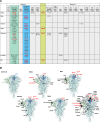The Impact of Evolving SARS-CoV-2 Mutations and Variants on COVID-19 Vaccines
- PMID: 35352979
- PMCID: PMC9040821
- DOI: 10.1128/mbio.02979-21
The Impact of Evolving SARS-CoV-2 Mutations and Variants on COVID-19 Vaccines
Abstract
The emergence of several new variants of severe acute respiratory syndrome coronavirus 2 (SARS-CoV-2) in recent months has raised concerns around the potential impact on ongoing vaccination programs. Data from clinical trials and real-world evidence suggest that current vaccines remain highly effective against the alpha variant (B.1.1.7), while some vaccines have reduced efficacy and effectiveness against symptomatic disease caused by the beta variant (B.1.351) and the delta variant (B.1.617.2); however, effectiveness against severe disease and hospitalization caused by delta remains high. Although data on the effectiveness of the primary regimen against omicron (B.1.1.529) are limited, booster programs using mRNA vaccines have been shown to restore protection against infection and symptomatic disease (regardless of the vaccine used for the primary regimen) and maintain high effectiveness against hospitalization. However, effectiveness against infection and symptomatic disease wanes with time after the booster dose. Studies have demonstrated reductions of varying magnitude in neutralizing activity of vaccine-elicited antibodies against a range of SARS-CoV-2 variants, with the omicron variant in particular exhibiting partial immune escape. However, evidence suggests that T-cell responses are preserved across vaccine platforms, regardless of variant of concern. Nevertheless, various mitigation strategies are under investigation to address the potential for reduced efficacy or effectiveness against current and future SARS-CoV-2 variants, including modification of vaccines for certain variants (including omicron), multivalent vaccine formulations, and different delivery mechanisms.
Keywords: COVID-19; SARS-CoV-2; mutation; vaccines; variant.
Conflict of interest statement
The authors declare a conflict of interest. GRM, TFS, BL, and PLM have no conflicts of interest to report. ÖT and US are management board members and employees at BioNTech SE (Mainz, Germany). JK has a grant from the Rockefeller Foundation to increase equity and representativeness in SARS-CoV-2 sequencing, has a role on an NIH grant to carry out SARS-CoV-2 sequencing and detection of viral variants, served on a BioNTech advisory panel, and holds stock in BioNTech and Pfizer, who manufacture COVID-19 vaccines. AM and SP are employees at BioNTech SE. AM, ÖT, and US are inventors on patents and patent applications related to RNA technology and COVID-19 vaccines. AM, ÖT, and US have securities from BioNTech SE.
Figures

References
-
- CoVariants. 2022. CoVariants. https://covariants.org/. Accessed 14 January, 2022.
Publication types
MeSH terms
Substances
Supplementary concepts
Grants and funding
LinkOut - more resources
Full Text Sources
Other Literature Sources
Medical
Miscellaneous

